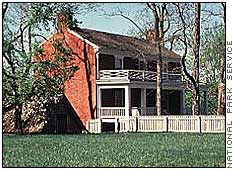
CHEROKEE, N.C. (CNN/Money) -
Here in America, there's no single thoroughfare that's been designated our official National Highway. But if there were, it's pretty obvious which road it would be: the Blue Ridge Parkway.
One of two long parkways administered by the National Park Service (the other is the Natchez Trace Parkway), the BRP is a 469-mile road that runs atop the crest of the Blue Ridge Mountains, beginning at the southern border of Shenandoah National Park in Virginia and ending at the doorstep of Great Smoky Mountains National Park in western North Carolina. It all adds up to an unbeatable string of spectacular Appalachian countryside.
Work on the BRP began in 1935 and was largely completed by the mid-1950s, although the final section wasn't in place until 1987. From a superficial standpoint, it's a rather ordinary road: two-lane blacktop the whole way, no stop signs or traffic lights, a 45-MPH speed limit, with numbered stone posts marking the miles along the roadside. But the roadway's winding, twisting path through the mountains is extraordinary, with spectacular mountain vistas visible from the Parkway's hundreds of scenic overlooks and turnouts. Hiking trails extend from the BRP into the forest, and roadside historic exhibits, many featuring log cabins and other preserved or restored buildings, explain what pioneer life was like in the region a century ago. The spring wildflower and fall foliage seasons just make the BRP that much more beautiful. It may not be our National Highway, but it's surely a national treasure.
The BRP passes by several excellent travel attractions located in surrounding towns, so it's often worthwhile to get off the Parkway (exits are plentiful) and see what's what. Here are a few that you really have to see:

Appomattox Court House National Historical Park
Route 24, Appomattox, Virginia
This site, about half an hour east of the BRP, is among the most storied in American history. It was here that the Confederate general Robert E. Lee surrendered to Ulysses S. Grant on April 9, 1865, effectively ending the Civil War. The exhibits are superb and the history palpable -- a very moving place.
The Virginia Museum of Transportation
303 Norfolk Ave., Roanoke, Virginia
The BRP passes right through the outskirts of Roanoke, making it easy to check out this excellent museum. Housed in an old railway freight station, it features a wonderful train yard filled with vintage locomotives, passenger cars, and cabooses, most of them open for interior walk-throughs.
The Blowing Rock
U.S. Highway 321 South, Blowing Rock, North Carolina
The Blowing Rock is a cliff where constant strong updrafts can cause objects tossed over the edge to fly up instead of fall down. The inspiration for several Indian legends, it's also a fun place to stretch your legs and chat with other travelers as you all toss pennies and whatnot over the ledge and watch them get blown back over your heads.
Linville Caverns
U.S. Highway 221, Marion, North Carolina
| |
 Related sites
Related sites
| |
| | |
| | |
|
If you like caves, you'll love Linville Caverns, an active limestone cave whose innumerable stalactites and stalagmites continue to drip their way to new formations. Guided tours tell the story of the site, and the cave's constant mid-50s temperatures make this a particularly good stop for hot summer days.
Looking Glass Falls
U.S. Highway 276, Outside Brevard, NC, about 10 miles south of milepost 411.
Located about 10 miles south of the BRP, and definitely worth the detour, Looking Glass Falls is among the most picturesque waterfalls in America. A perfect place to take a breather and unwind after a long day of driving.
Finally, for an authentic local soundtrack while driving the BRP, tune your car radio to WPAQ (740 AM), a North Carolina station that plays classic Appalachian bluegrass music and also broadcasts sermons by some serious fire-and-brimstone preachers. The mountains sometimes make radio reception spotty, but you should be able to get WPAQ from about BRP milepost 100 to milepost 300.

|

